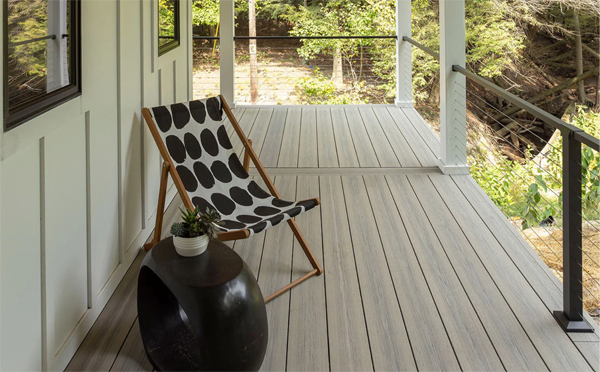Choosing the right decking material transforms your outdoor space. Two top contenders dominate today’s market: mineral-based composite (MBC) and wood-plastic composite (WPC). Each offers distinct strengths and quirks. So, let’s dive in, explore their differences, weigh the pros and cons, and decide which suits your deck best.
Mineral-Based Composite Decking: The Bold Innovator
MBC decking, like Deckorators’ Voyage and Vault, skips wood fibers entirely. Instead, it mixes polypropylene with calcium carbonate and tops it with a tough polyethylene cap. This cutting-edge combo, driven by Surestone® Technology, delivers a lightweight yet sturdy option.


Pros:
- Stays Cool: MBC dodges heat better than WPC. Its mineral core and reflective cap keep barefoot strolls comfortable, even on blazing days.
- Holds Steady: With almost no thermal expansion, MBC locks in tight joints. It thrives in wild weather swings without shifting.
- Lasts Forever: No organic bits mean MBC resists rot, mold, and bugs effortlessly. Plus, a 50-year warranty (like Voyage’s) backs its toughness for wet spots like docks.
- Grips Well: Voyage’s textured finish boosts slip resistance by 34% over rivals in wet tests. Safety wins here.
Cons:
- Costs More: MBC demands a bigger upfront investment. That price jump might hurt for large decks.
- Fewer Looks: MBC offers solid variety, but its colors and grains don’t mimic wood as closely as WPC does.
- Feels Dense: Though lighter than concrete, MBC’s solid build can challenge DIYers during setup.
Wood-Plastic Composite Decking: The Reliable Classic
WPC decking, found in Deckorators’ Venture and Vista, blends recycled wood fibers with plastic—usually polyethylene. It captures wood’s charm without the upkeep hassles. This mainstay launched the composite craze and still hooks plenty of fans.


Pros:
- Saves Cash: WPC costs less upfront. It fits tight budgets or small projects perfectly.
- Looks Great: WPC nails wood vibes. Vista’s Ironwood channels exotic flair, while Venture’s Saltwater keeps it sleek and modern.
- Goes Green: With up to 95% recycled content, WPC turns waste into beauty. Eco-warriors rejoice.
- Installs Easy: Contractors and DIYers love WPC’s light weight and simple setup. It speeds up build time.
Cons:
- Heats Up: Wood fibers and dark shades soak up sun. WPC can hit 120-130°F, scorching bare feet.
- Shifts Slightly: Temperature swings stretch or shrink WPC. You’ll need wider gaps (up to 5/16”), and it might wiggle over time.
- Wears Faster: Capped WPC fights moisture well, but it falters in extreme wet zones. Warranties often stop at 25 years.
- Slips More: WPC’s traction depends on texture. Yet, it rarely matches MBC’s grip, especially when wet.
The Winner: Who Takes the Crown?
Now, which rules supreme—MBC or WPC? Your deck’s purpose decides, but mineral-based composite grabs the edge for long-haul champs. It keeps cool, stands firm, and outlasts rivals. Sure, the cost bites initially, but MBC shrugs off heat, water, and wear like a pro. That durability could save you from future rebuilds. Meanwhile, WPC shines for budget builds and wood lovers. It delivers style and savings for simpler setups. So, chase longevity and tech? MBC wins. Prioritize cost and cozy wood feels? WPC holds strong. Match your pick to your deck’s future—both beat splintery old boards hands down.
What’s your call—going mineral or sticking with wood-plastic flair? Let me know and schedule your deck estimate today!

